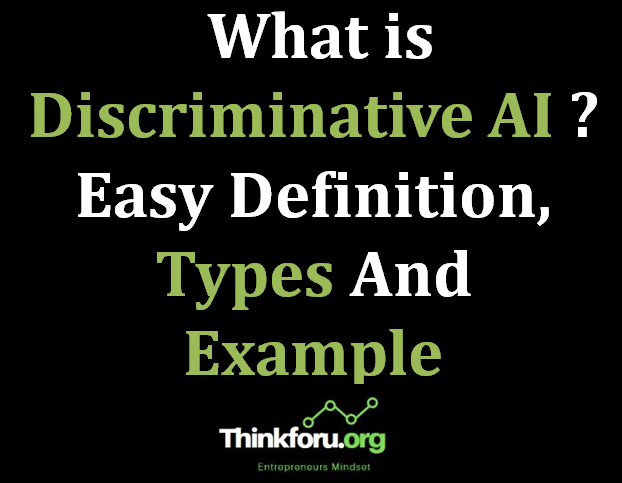What is Discriminative AI ? Easy Definition ,Types And Example
Discriminative AI refers to a type of artificial intelligence that focuses on learning the mapping function directly from input data to output predictions, without explicitly modeling the underlying probability distribution of the data. In other words, discriminative models aim to distinguish between different classes or categories in the input data.
Easy Definition Of Discriminative AI:
Discriminative AI is a type of artificial intelligence that directly learns the relationships between input data and output predictions without explicitly modeling the entire probability distribution of the data.
Types Of Discriminative AI:
1. Logistic Regression: A simple discriminative model commonly used for binary classification tasks.2. Support Vector Machines (SVM): Another method for binary or multiclass classification by finding a hyperplane that best separates different classes.3. Neural Networks (for Classification): Deep learning models with softmax activation in the output layer, suitable for classification tasks.4. Decision Trees and Random Forests: Tree-based models that make decisions based on features to classify data into different categories.
Example Of Discriminative AI:
Consider the task of classifying emails as either spam or not spam.In discriminative AI:Logistic Regression: The model learns a linear boundary in the feature space to separate spam and non-spam emails.Neural Network: A deep learning model with an output layer using softmax activation, which assigns probabilities to each class (spam or non-spam) based on the input features.In contrast, generative models, like Gaussian Mixture Models or Naive Bayes, would model the entire distribution of both spam and non-spam emails and then generate new samples from these distributions. Discriminative models tend to be more straightforward for classification tasks and often achieve high accuracy in practice.
Let's delve a bit deeper into discriminative AI, exploring its characteristics, advantages, and a few more examples.
Characteristics of Discriminative AI:1. Focus on Decision Boundary: Discriminative models concentrate on learning the decision boundary that separates different classes in the input space.2. Conditional Probability: These models directly estimate the conditional probability of the output given the input, P(output | input).3. Direct Prediction: The primary goal is to make accurate predictions without explicitly modeling the joint distribution of input and output variables.
Advantages of Discriminative AI:1. Efficiency: Discriminative models often require less computational resources compared to generative models because they don't need to model the entire data distribution.2. Better Performance for Classification: Discriminative models are well-suited for tasks like classification, where the focus is on distinguishing between classes.3. Robustness: These models can be more robust to changes in the input data distribution, making them suitable for various real-world applications.
Additional Examples:4. Support Vector Machines (SVM): SVM is a discriminative model that finds a hyperplane to separate different classes. It is widely used for both binary and multiclass classification.5. Nearest Neighbors: The k-nearest neighbors (KNN) algorithm is a discriminative method where an input is classified based on the majority class among its k-nearest neighbors in the feature space.6. Linear Discriminant Analysis (LDA): LDA is a discriminative model used for dimensionality reduction and classification. It aims to find a linear combination of features that characterizes and separates classes.7. Conditional Random Fields (CRF): CRFs are discriminative models often used in structured prediction tasks, such as sequence labeling in natural language processing.
Let's explore a few more examples and concepts related to discriminative AI:
8. Multinomial Logistic Regression (Softmax Regression):This is an extension of binary logistic regression to handle multiple classes. It's commonly used in multiclass classification problems, where the model predicts the probability distribution over multiple classes.
9. Conditional Generative Adversarial Networks (cGAN):While GANs are generative models, cGANs introduce a discriminative element by training a discriminator to distinguish between real and generated samples. The generator then aims to produce samples that are indistinguishable from real ones.
10. XGBoost (Extreme Gradient Boosting):XGBoost is a powerful discriminative model used for supervised learning tasks, especially in structured/tabular data scenarios. It combines the predictions from multiple weak learners (trees) to improve accuracy and generalization.
11. Maximum Entropy Models (MaxEnt):MaxEnt models are used in natural language processing for tasks like part-of-speech tagging. They seek to maximize the entropy of the predicted distribution, subject to constraints imposed by the training data.
12. Perceptron:A basic building block of neural networks, the perceptron is a simple discriminative model used for binary classification. It takes input features, applies weights, and produces an output based on a threshold.
13. Conditional Variational Autoencoders (cVAE):VAEs are generative models, but cVAEs incorporate a discriminative element by considering conditional information. They are used in generating data while conditioning on specific attributes.
14. Fisher's Linear Discriminant:Similar to Linear Discriminant Analysis (LDA), Fisher's Linear Discriminant aims to find the linear combination of features that maximally separates different classes in a classification problem.
15. One-Class SVM:While SVMs are often used for binary or multiclass classification, One-Class SVM is a discriminative model designed for anomaly detection. It learns to identify normal instances and flags deviations as anomalies.
These examples showcase the versatility of discriminative models across various domains, from traditional statistical methods to modern machine learning algorithms. Discriminative AI continues to be a dominant paradigm, particularly in tasks where the emphasis is on accurate classification and prediction.
Discriminative AI models are designed for making direct predictions and are particularly effective in classification tasks. They offer efficiency, simplicity, and robust performance in various applications.


Post a Comment